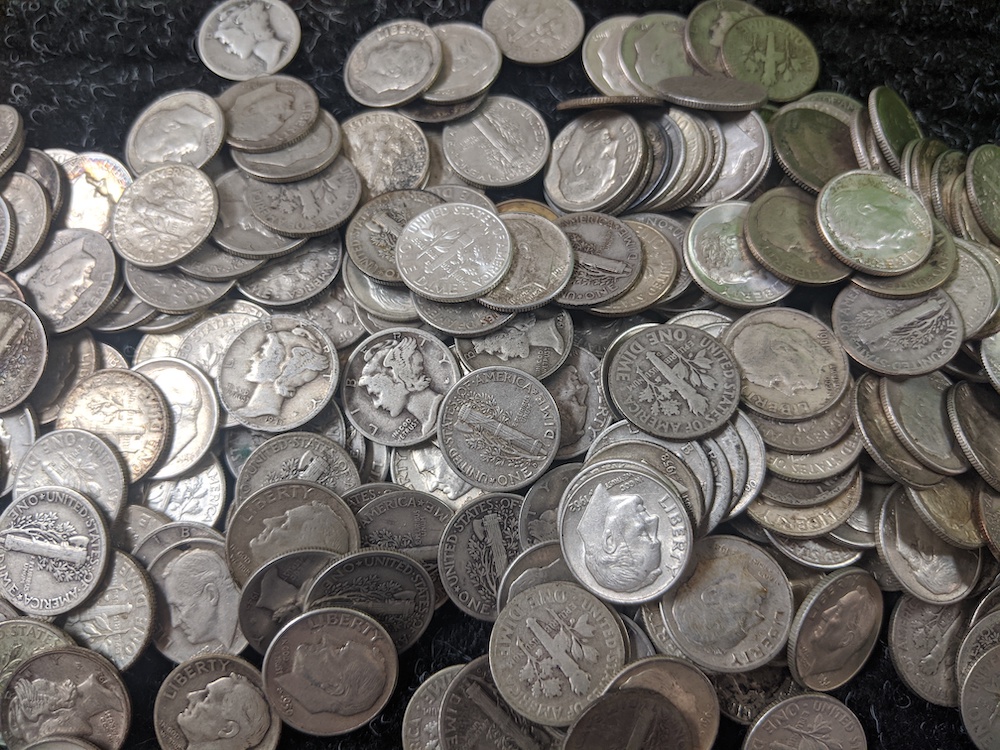Oakton Coins & Collectibles is open for business. Buying and selling all collectible coins / paper money (U.S. and world), all forms of gold & silver, bullion, estate jewelry, stamps, diamonds, and more.
As a coin shop that buys and sells, we come in contact with a lot of people who have inherited coin collections. No matter the size, you can bring it in for a free verbal appraisal. Often people sell the whole collection. Sometimes, they sell the valuable parts and split up the rest between siblings. Maybe it’s a small collection without a lot of monetary value and you have someone young in your family that would appreciate it.
This is a quick guide to help identify your inherited coins at home….. Cents, Half Dimes & Nickels, Dimes, Quarters, Half Dollars, Silver Dollars, US Gold Coins, Early American Medals/Commemorative Coins, and Modern Commemoratives.
Types of United States Mint Dimes.
Silver Liberty Seated Dimes (1837-1891) Christian Gobrecht completed the design of the Seated Liberty dime, whose obverse was used with every circulating silver U.S. coin of the period. Mint Director Robert Maskell Patterson requested a new coin design, to be reminiscent of the Britannia image found on coinage of the United Kingdom. Chief Engraver William Kneass drew the original sketches, but suffered a stroke and was too ill to finish them or to oversee preparation of the dies. The task then fell to Gobrecht, who was promoted to Second Engraver.
The obverse features an image of Liberty sitting on a rock, wearing a dress and holding a staff with a liberty cap on top. Her right hand is balancing a shield with the inscription “LIBERTY.” The reverse featured the inscription “ONE DIME,” surrounded by a wreath. All Seated Liberty dimes contain 90% silver and 10% copper, and are 17.9 millimeters (0.705 inch) in diameter. This size and metal composition would continue until 1965, when silver was permanently removed from circulating dimes.
Silver Mercury Dime (1916-1945) Although most commonly referred to as the “Mercury” dime, the Winged Liberty Head does not depict the Roman messenger god. The obverse figure is a depiction of the mythological goddess Liberty wearing a Phrygian cap, a classic Western symbol of liberty and freedom, with its wings intended to symbolize freedom of thought. Designed by noted sculptor Adolph A. Weinman, the Winged Liberty Head dime is considered by many to be one of the most beautiful U.S. coin designs ever produced. The composition (90% silver, 10% copper) and diameter (17.9 millimeters) of the “Mercury” dime was unchanged from the Barber dime.
Weinman (who had studied under Augustus Saint-Gaudens) won a 1915 competition against two other artists for the design job, and is thought to have modeled his version of Liberty on Elsie Kachel Stevens, wife of noted poet Wallace Stevens. The reverse design, a fasces juxtaposed with an olive branch, was intended to symbolize America’s readiness for war, combined with its desire for peace. Although the fasces was later officially adopted by Benito Mussolini and his National Fascist Party, the symbol was also common in American iconography and has generally avoided any stigma associated with its usage in wartime Italy.
Silver Barber Dime (1892-1916) The Barber dime is named for its designer, Charles E. Barber, who was Chief Engraver of the U.S. Mint from 1879 to 1917. The design was shared with the quarter and half-dollar of the same period. Extensive internal politics surrounded the awarding of the design job, which had initially been opened to the public. A four-member committee (which included Barber), appointed by then-Mint Director James Kimball, accorded only two of more than 300 submissions an honorable mention. Kimball’s successor, Edward O. Leech, decided to dispense with the committees and public design competitions and simply instructed Barber to develop a new design. It has been speculated that this is what Barber had wanted all along.
The Barber dime, as with all previous dimes, featured an image of Liberty on the obverse. She is wearing a Phrygian cap, a laurel wreath with a ribbon, and a headband with the inscription “LIBERTY“. This inscription is one of the key elements used in determining the condition of Barber dimes. Liberty’s portrait was inspired by two sources—French coins and medals of the period, as well as ancient Greek and Roman sculpture. The obverse also contains the long-used 13 stars (for the 13 colonies) design element. The reverse contained a wreath and inscription almost identical to the one used on the final design of the Seated Liberty dime
Roosevelt Dime (1946-1964 silver, 1965- present clad (not silver)) Soon after the death of President Franklin D. Roosevelt in 1945, legislation was introduced by Virginia Congressman Ralph H. Daughton called for the replacement of the Mercury dime with one bearing Roosevelt’s image. The dime was chosen to honor Roosevelt partly due to his efforts in the founding of the National Foundation for Infantile Paralysis (later renamed the March of Dimes), which originally raised money for polio research and to aid victims of the disease and their families.
Due to the limited amount of time available to design the new coin, the Roosevelt dime was the first regular-issue U.S. coin designed by a Mint employee in more than 40 years. Chief Engraver John R. Sinnock was chosen, as he had already designed a Mint presidential medal of Roosevelt. Sinnock’s first design, submitted on October 12, 1945, was rejected, but a subsequent one was accepted on January 6, 1946. The dime was released to the public on January 30, 1946, which would have been Roosevelt’s 64th birthday. Sinnock’s design placed his initials (“JS”) at the base of Roosevelt’s neck, on the coin’s obverse. His reverse design elements of a torch, olive branch, and oak branch symbolizes, respectively, liberty, peace, and strength.

